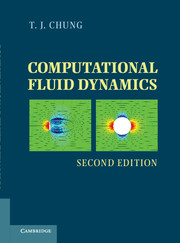Book contents
- Frontmatter
- Contents
- Preface to the First Edition
- Preface to the Revised Second Edition
- Part One Preliminaries
- Part Two Finite Difference Methods
- Part Three Finite Element Methods
- Part Four Automatic Grid Generation, Adaptive Methods, and Computing Techniques
- Chapter Seventeen Structured Grid Generation
- Chapter Eighteen Unstructured Grid Generation
- Chapter Nineteen Adaptive Methods
- Chapter Twenty Computing Techniques
- Part Five Applications
- Appendixes
- Index
- References
Chapter Twenty - Computing Techniques
from Part Four - Automatic Grid Generation, Adaptive Methods, and Computing Techniques
Published online by Cambridge University Press: 05 June 2012
- Frontmatter
- Contents
- Preface to the First Edition
- Preface to the Revised Second Edition
- Part One Preliminaries
- Part Two Finite Difference Methods
- Part Three Finite Element Methods
- Part Four Automatic Grid Generation, Adaptive Methods, and Computing Techniques
- Chapter Seventeen Structured Grid Generation
- Chapter Eighteen Unstructured Grid Generation
- Chapter Nineteen Adaptive Methods
- Chapter Twenty Computing Techniques
- Part Five Applications
- Appendixes
- Index
- References
Summary
In Part Two and Part Three, various numerical schemes in CFD including FDM, FEM, and FVM have been discussed. We have presented methods of grid generation and adaptive meshing in both structured and unstructured grids in Part Four. Equation solvers for both linear and nonlinear algebraic equations resulting from FDM, FEM, and FVM have also been discussed in appropriate chapters. We are now at the stage of embarking on extensive CFD calculations in large-scale industrial problems, which will be presented in Part Five. To this end, it is informative to examine computational aspects associated with supercomputer applications and multi-processors. Among them are the domain decomposition methods (DDM), multigrid methods (MGM), and parallel processing. In DDM the domain of study is partitioned into substructures to make solvers perform more efficiently with reduction of storage requirements, whereas in MGM the solution convergence is accelerated with low-frequency errors being removed through coarse mesh configurations and with high-frequency errors removed through fine mesh configurations. These two methods lend themselves to parallel processing to speed up and reduce computer time. Development of parallel programs and both static and dynamic load balancing will be presented. The topics in this chapter are designed toward more robust computational strategies in dealing with geometrically complicated, large-scale CFD problems. Some selected example problems are also included.
Domain Decomposition Methods
In dealing with geometrically large, complicated systems, it is natural to seek an approach to split the domain into small pieces, known as domain decomposition methods (DDM). This is one of many possible applications to parallel processing to be discussed in Section 20.3. The basic idea of DDM was originated from the concept of linear algebra in solving the partial differential equations iteratively in subdomains, known as the Schwarz method [Schwarz, 1869]; and subsequently implemented in applications [Lions, 1988; Glowinski and Wheeler, 1988, among others]. The main advantages of DDM include efficiency of solvers, savings in computational storage conducive to parallel processing, and applications of different differential equations in different subdomains (representing viscous flow in one subdomain and inviscid flow in another subdomain, for example).
Information
- Type
- Chapter
- Information
- Computational Fluid Dynamics , pp. 654 - 686Publisher: Cambridge University PressPrint publication year: 2010
